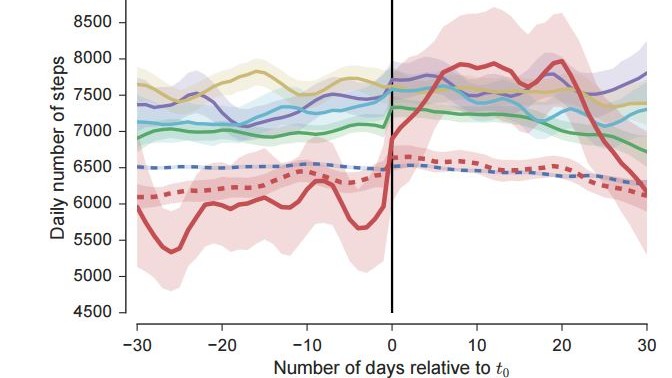Pokemon Go Increased U.S. Activity Levels by 144 Billion Steps in Just 30 Days
Robert Butler, the founding director of the National Institute on Aging, once said: “If exercise could be purchased in a pill, it would be the single most widely prescribed and beneficial medicine in the nation.”
However, exercise is a bitter pill for many people to swallow. Less than a quarter of adults in the U.S. meet recommended activity level of 150 minutes a week. And less than a third of schoolchildren get the recommended 60 minutes a day.
That’s despite numerous public health initiatives to stimulate exercise levels and an increasing armory of devices that can measure it. Most interventions turn out to be ineffective, to reach only those who are already active or cannot be scaled across demographic, cultural, and geographic groups.

But earlier in 2016, all that looked set to change with the release of Pokemon Go, an augmented reality game played on a smartphone. Pokemon Go spread around the world like wildfire with the U.S. alone having 25 million active players.
The game requires players to move around the real world and rewards them for the amount of activity they do. And that raises an interesting question: has Pokemon Go had a significant impact on the activity levels of the people who play it?
Today we get an answer thanks to the work of Eric Horvitz and pals at Microsoft Research in Redmond, Washington. These guys have gathered strong evidence that Pokemon Go has had a dramatic impact on activity levels. And significantly, this includes people who are traditionally difficult to motivate, such as those who are overweight and obese.
The researchers have no access to the game itself and so have had to find another way to study players. They’ve done this by mining two large Microsoft datasets that they do have access to. The first is the data associated with some 30,000 users of the Microsoft Band, an activity-monitoring wristband that collects data and stores it in the cloud. The second data set consists of searches carried out on Microsoft’s search engine Bing.
These guys simply search each Microsoft Band user’s Bing queries for terms related to Pokemon Go. These are searches such as "how to play pokemon go" and "pokemon go eevee evolution," which indicate that the user is an active player of Pokemon Go.
By this measure, 1,420 people out of the 30,000 Microsoft Band users turn out to be Pokemon Go players. And the team assumes users start playing the game on the day they begin making these kinds of searches.
Next, Horvitz and co analyze each player’s activity levels in the 30 days before starting the game and compare this to the 30 days after. And finally, they compare these activity levels to those of 50,000 randomly chosen Microsoft Band wearers to rule out additional factors that might change activity levels, such as bad weather.
The results make fascinating reading. On average, Pokemon Go players increase the number of steps they took each day by 1,473. That’s a 25 percent increase over 30 days.
If the same effect plays out across all Pokemon Go users, that translates into a dramatic increase in activity. “In the short time span of the study, we estimate that Pokémon Go has added a total of 144 billion steps to U.S. physical activity,” say Horvitz and co.
What’s more, the game increases activity levels for men and women of all ages, regardless of their weight. That’s something that other fitness initiatives have singularly failed to do.
That has important implications for public health. Increased activity has a direct effect on life expectancy. Horvitz and co calculate that if players keep up this increased activity level, the game could add some 2.8 million years of additional life to U.S. players alone. That has all kinds of implications for health services, for public finances, pensions, and so on.
The question now is what to learn from this episode that can be translated into other health-related initiatives. That’s not going to be easy to answer. Game designers have long pursued the elusive ingredient that makes people want to play. None have truly mastered it.
But Pokemon Go seems to have.
It may not be possible to purchase exercise as a pill but it looks increasingly likely that it can be packaged and distributed in other ways. Butler would surely be impressed.
Ref: arxiv.org/abs/1610.02085: Influence of Pokémon Go on Physical Activity: Study and Implications
Deep Dive
Policy
Is there anything more fascinating than a hidden world?
Some hidden worlds--whether in space, deep in the ocean, or in the form of waves or microbes--remain stubbornly unseen. Here's how technology is being used to reveal them.
A brief, weird history of brainwashing
L. Ron Hubbard, Operation Midnight Climax, and stochastic terrorism—the race for mind control changed America forever.
What Luddites can teach us about resisting an automated future
Opposing technology isn’t antithetical to progress.
Africa’s push to regulate AI starts now
AI is expanding across the continent and new policies are taking shape. But poor digital infrastructure and regulatory bottlenecks could slow adoption.
Stay connected
Get the latest updates from
MIT Technology Review
Discover special offers, top stories, upcoming events, and more.